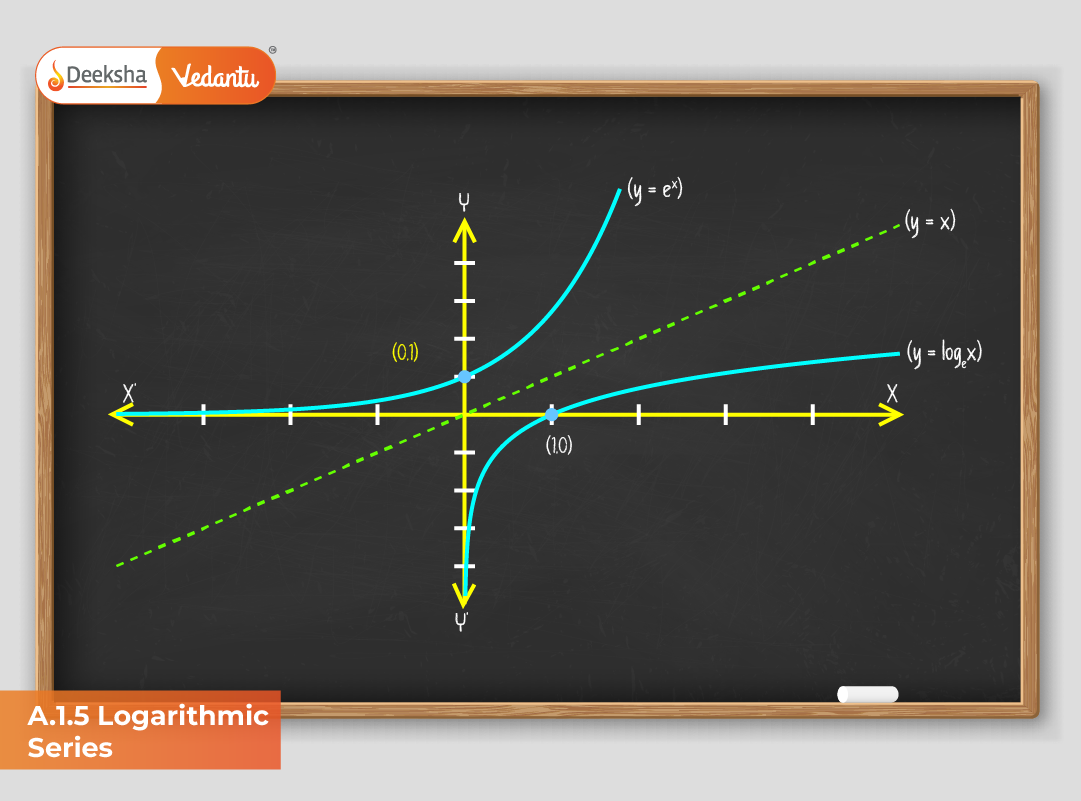
Overview
The Logarithmic Series is one of the fundamental expansions in mathematics, serving as a bridge between calculus, algebra, and analysis. For JEE aspirants, mastering this topic is vital because it frequently appears in problems involving differentiation, integration, approximation, and series convergence. The logarithmic function—particularly the natural logarithm—is crucial for understanding exponential growth, limits, and mathematical modeling in physics, chemistry, and economics.
The logarithmic series provides a method to express log(1 + x) as an infinite sum. This concept not only enhances comprehension of infinite series but also helps approximate logarithmic values without calculators—an essential skill in competitive exams like JEE Main and Advanced.
Definition
For any real number x where |x| ≤ 1 and x ≠ 1, the logarithmic series can be represented as:
log(1 + x) = x – x²/2 + x³/3 – x⁴/4 + x⁵/5 – … to ∞
This infinite series is alternating in nature, meaning the terms successively change signs (positive, negative, positive, etc.), and the magnitude of each successive term decreases gradually. This property ensures conditional convergence within a specific range of x.
Step-by-Step Derivation
Let f(x) = log(1 + x). To derive the infinite expansion, differentiate both sides:
df/dx = 1 / (1 + x)
Now expand 1 / (1 + x) using the geometric progression (GP) formula:
1 / (1 + x) = 1 – x + x² – x³ + x⁴ – x⁵ + … for |x| < 1
Integrate both sides term by term from 0 to x:
∫₀ˣ (1 / (1 + t)) dt = ∫₀ˣ (1 – t + t² – t³ + t⁴ – …) dt
Evaluating gives:
log(1 + x) = x – x²/2 + x³/3 – x⁴/4 + x⁵/5 – … + (-1)(n+1) * xⁿ / n + …
This establishes the Logarithmic Series Expansion, which is conditionally convergent for -1 < x ≤ 1.
General Form
The compact representation of the series is:
log(1 + x) = Σ [(-1)(n+1) * xⁿ / n], where n = 1, 2, 3, … ∞
Convergence Analysis
The convergence of the series is determined by the ratio test and alternating series test:
- For -1 < x < 1: The series converges absolutely.
- At x = 1: The series becomes log(2) = 1 – 1/2 + 1/3 – 1/4 + 1/5 – …, which converges conditionally.
- At x = -1: The series diverges since log(0) is undefined.
Thus, the region of convergence is -1 < x ≤ 1.
Graphical Insight
If plotted, log(1 + x) aligns closely with the polynomial curve formed by the partial sums of the logarithmic series. As the number of terms increases, the approximation becomes more accurate for values within the convergence range.
Key Properties of the Logarithmic Series
- Alternating Sign Property: The series alternates between positive and negative signs.
- Decreasing Term Magnitude: Each term’s absolute value decreases with increasing n.
- Conditional Convergence: The series converges conditionally but not absolutely for x = 1.
- Differentiability: Term-by-term differentiation gives the geometric series expansion for 1/(1 + x).
- Approximations for Small x: For small x, log(1 + x) ≈ x, a useful approximation for limits and estimations.
Relationship with Exponential Series
The logarithmic and exponential series are deeply interlinked. Consider the exponential expansion:
eˣ = 1 + x + x²/2! + x³/3! + x⁴/4! + …
Taking the natural logarithm on both sides yields:
log(eˣ) = x
Through differentiation and integration, one can establish that the logarithmic series is the inverse process of the exponential expansion. In essence, the exponential and logarithmic series represent inverse functions in calculus.
Advanced Properties and Transformations
- Derivative of the Logarithmic Series: Differentiating log(1 + x) gives 1/(1 + x), confirming the correctness of the derived expansion.
- Integral Representation: Integrating the logarithmic series helps evaluate integrals involving rational functions.
- Alternate Series Forms: By substituting x with -x, one obtains log(1 – x) = -x – x²/2 – x³/3 – x⁴/4 – …
- Sum and Difference Formulas: Combining log(1 + x) and log(1 – x) leads to useful forms like:
- log((1 + x)/(1 – x)) = 2(x + x³/3 + x⁵/5 + …)
- log(1 – x²) = -x² – x⁴/2 – x⁶/3 – …
Applications in JEE Mathematics
- Series Expansion: Simplifying logarithmic expressions and functions.
- Limit Evaluation: Using log(1 + x) ≈ x for small x.
- Differentiation and Integration: Helps solve calculus problems involving logarithmic functions.
- Approximation Techniques: Used to estimate values like log(1.01), log(1.1), etc.
- Advanced Calculus: Crucial for Taylor and Maclaurin series-based problems.
Marks Weightage in JEE
| Exam | Topic | Average Weightage | Difficulty Level |
| JEE Main | Infinite Series & Logarithmic Series | 4 Marks | Moderate |
| JEE Advanced | Power Series & Logarithmic Series | 6–8 Marks | Moderate to Difficult |
Sample Problems and Solutions
Problem 1:
Expand log(1 + x) up to the fourth term.
Solution:
log(1 + x) = x – x²/2 + x³/3 – x⁴/4.
Problem 2:
Evaluate log(2) using the series.
Solution:
For x = 1,
log(2) = 1 – 1/2 + 1/3 – 1/4 + 1/5 – … ≈ 0.693.
Problem 3:
Approximate log(1.1) using the first three terms.
Solution:
For x = 0.1,
log(1.1) ≈ 0.1 – 0.005 + 0.000333 = 0.0953.
Problem 4:
Show that log((1 + x)/(1 – x)) = 2[x + x³/3 + x⁵/5 + …].
Solution:
Use log(1 + x) – log(1 – x) and apply their respective series.
Problem 5 (Advanced):
Prove that log(1 + x²) = 2(x²/2 – x⁴/4 + x⁶/6 – …)
Solution:
Substitute x² in the logarithmic series expansion.
Real-World Applications
- Physics: Measuring sound intensity in decibels (logarithmic scale)
- Engineering: Signal-to-noise ratio and gain calculation
- Economics: Modeling compound interest and growth
- Computer Science: Logarithmic complexity in algorithm analysis
- Biology: Population growth modeled using log functions
Comparison: Logarithmic vs Exponential Series
| Property | Logarithmic Series | Exponential Series |
| Function | log(1 + x) | eˣ |
| General Term | (-1)(n+1) xⁿ / n | xⁿ / n! |
| Convergence | -1 < x ≤ 1 | All x |
| Nature | Alternating | Always Positive |
| Relation | Inverse of exponential | Inverse of logarithmic |
FAQs
Q1. What is the formula for the logarithmic series?
log(1 + x) = x – x²/2 + x³/3 – x⁴/4 + … to ∞
Q2. What is the convergence range of the logarithmic series?
It converges for -1 < x ≤ 1 and diverges outside this interval.
Q3. Why is the logarithmic series important for JEE?
It is essential for solving problems in limits, calculus, and series expansion, frequently appearing in both JEE Main and Advanced.
Q4. How is the logarithmic series related to the exponential series?
They are inverse relationships—while exponential series represent eˣ, the logarithmic series represents log(1 + x), connecting through differentiation and integration.
Q5. Can the logarithmic series be used for approximations?
Yes, especially for small values of x. For instance, log(1 + x) ≈ x when x is very small.
Q6. How do you apply the logarithmic series in real life?
It is used in scientific measurements, data compression, and any process that exhibits exponential or logarithmic behavior.
Conclusion
The Logarithmic Series offers deep insight into the behavior of the natural logarithm through infinite expansion. It stands as a cornerstone topic in calculus and mathematical analysis, with wide applications in science and engineering. For JEE aspirants, understanding every nuance—from convergence tests to real-world modeling—is crucial for achieving precision in problem-solving. Mastering the logarithmic series not only boosts exam performance but also strengthens one’s conceptual command over advanced mathematics and its interconnected branches.






Get Social